Reflective Journal: ECON6000 Economic Principles and Decision Making
VerifiedAdded on 2022/08/14
|8
|1681
|20
Journal and Reflective Writing
AI Summary
This reflective journal analyzes the application of microeconomic and macroeconomic concepts to the Australian economy. The student reflects on two assessments: the first focuses on microeconomic principles, using the Australian housing market volatility as a case study, examining demand, supply, and elasticity. The second assessment explores macroeconomic principles, using Australia's slow economic growth as a case study, analyzing GDP components, consumption, investment, and global factors. The journal highlights the practical application of economic theories, discussing the impact of economic fluctuations on businesses and investors, and concludes with a reflection on how the course has improved the student's understanding of economic principles and decision-making in a business environment.
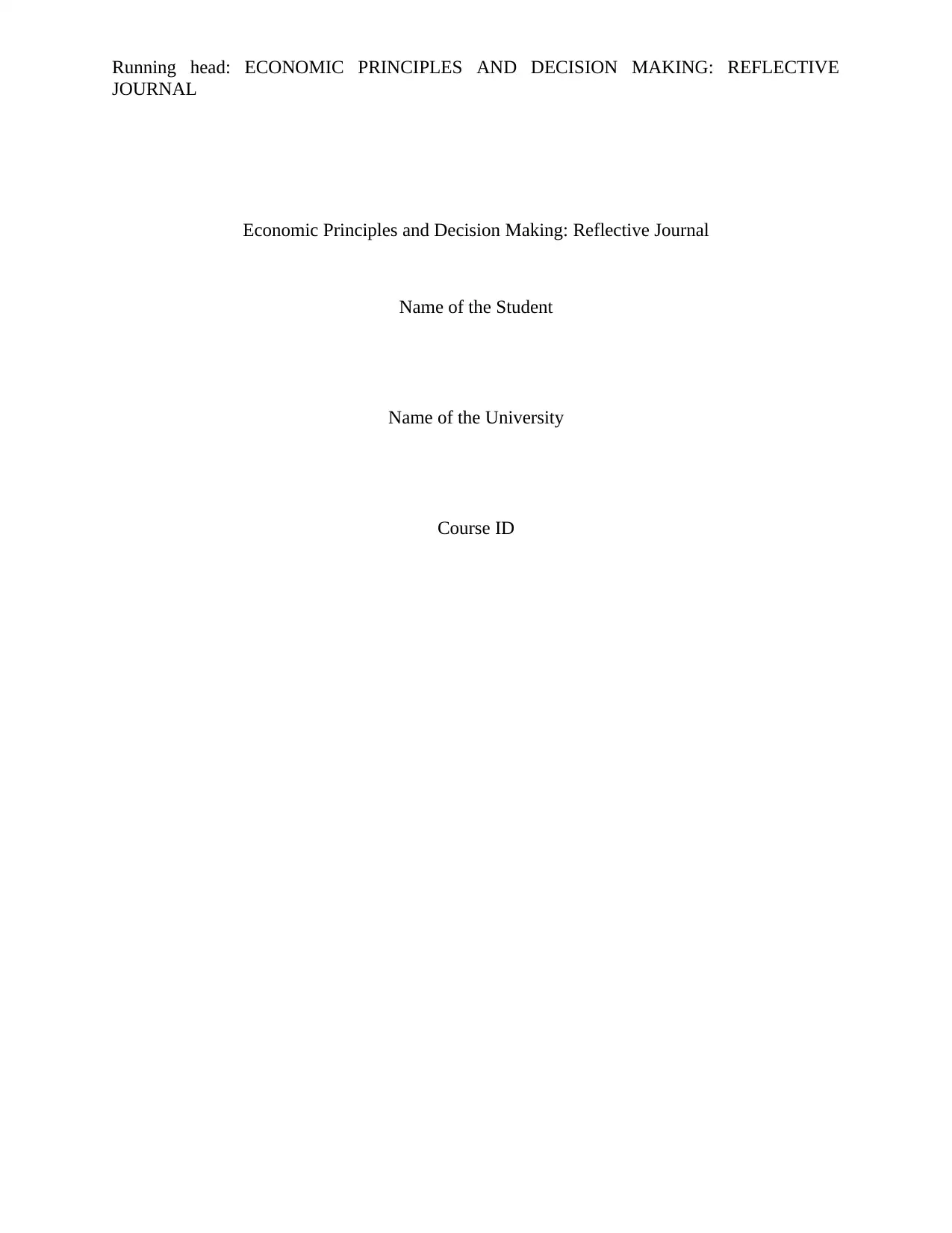
Running head: ECONOMIC PRINCIPLES AND DECISION MAKING: REFLECTIVE
JOURNAL
Economic Principles and Decision Making: Reflective Journal
Name of the Student
Name of the University
Course ID
JOURNAL
Economic Principles and Decision Making: Reflective Journal
Name of the Student
Name of the University
Course ID
Paraphrase This Document
Need a fresh take? Get an instant paraphrase of this document with our AI Paraphraser

1ECONOMIC PRINCIPLES AND DECISION MAKING: REFLECTIVE JOURNAL
Table of Contents
Reflective on assessment 1 and assessment 2..................................................................................2
Table of Contents
Reflective on assessment 1 and assessment 2..................................................................................2
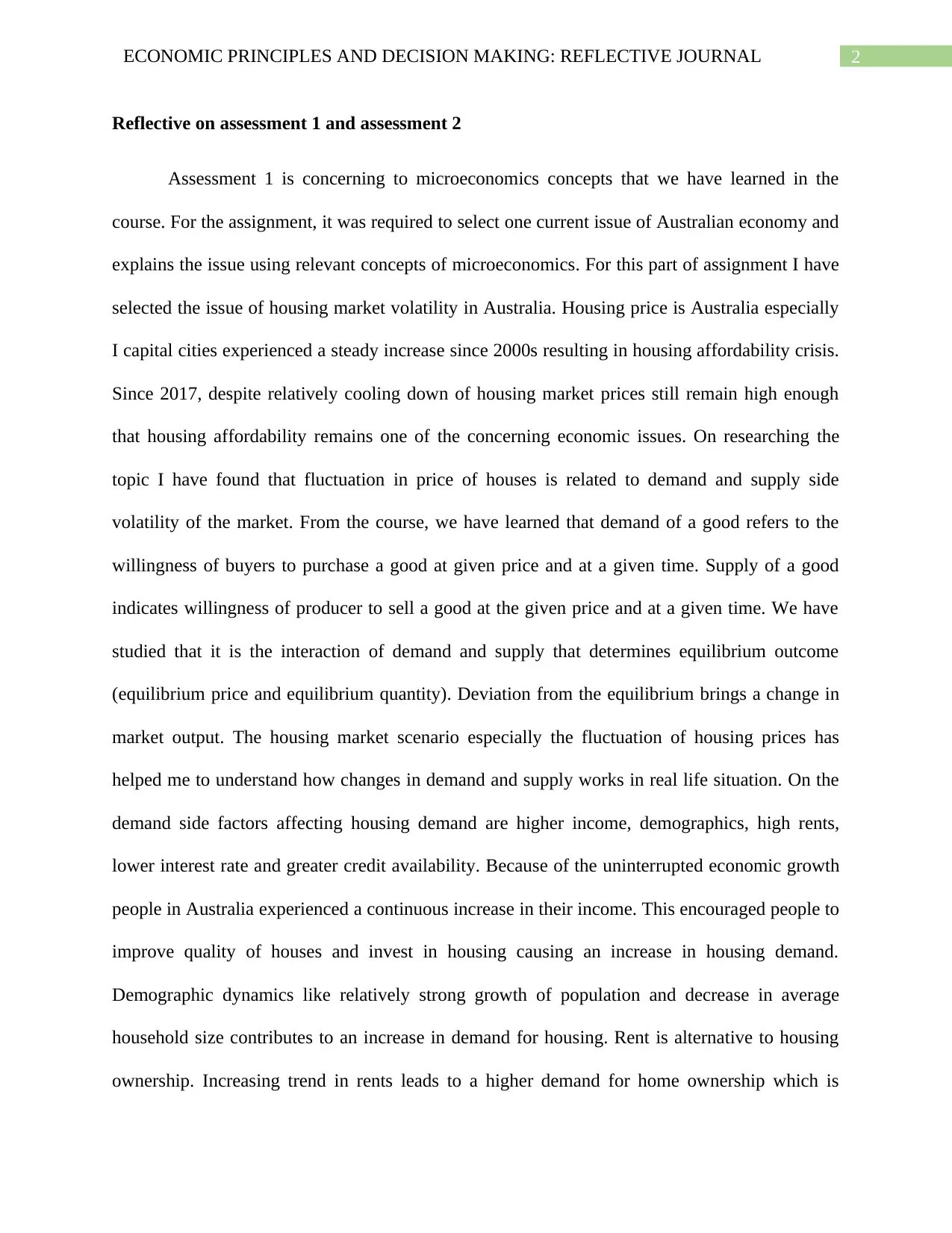
2ECONOMIC PRINCIPLES AND DECISION MAKING: REFLECTIVE JOURNAL
Reflective on assessment 1 and assessment 2
Assessment 1 is concerning to microeconomics concepts that we have learned in the
course. For the assignment, it was required to select one current issue of Australian economy and
explains the issue using relevant concepts of microeconomics. For this part of assignment I have
selected the issue of housing market volatility in Australia. Housing price is Australia especially
I capital cities experienced a steady increase since 2000s resulting in housing affordability crisis.
Since 2017, despite relatively cooling down of housing market prices still remain high enough
that housing affordability remains one of the concerning economic issues. On researching the
topic I have found that fluctuation in price of houses is related to demand and supply side
volatility of the market. From the course, we have learned that demand of a good refers to the
willingness of buyers to purchase a good at given price and at a given time. Supply of a good
indicates willingness of producer to sell a good at the given price and at a given time. We have
studied that it is the interaction of demand and supply that determines equilibrium outcome
(equilibrium price and equilibrium quantity). Deviation from the equilibrium brings a change in
market output. The housing market scenario especially the fluctuation of housing prices has
helped me to understand how changes in demand and supply works in real life situation. On the
demand side factors affecting housing demand are higher income, demographics, high rents,
lower interest rate and greater credit availability. Because of the uninterrupted economic growth
people in Australia experienced a continuous increase in their income. This encouraged people to
improve quality of houses and invest in housing causing an increase in housing demand.
Demographic dynamics like relatively strong growth of population and decrease in average
household size contributes to an increase in demand for housing. Rent is alternative to housing
ownership. Increasing trend in rents leads to a higher demand for home ownership which is
Reflective on assessment 1 and assessment 2
Assessment 1 is concerning to microeconomics concepts that we have learned in the
course. For the assignment, it was required to select one current issue of Australian economy and
explains the issue using relevant concepts of microeconomics. For this part of assignment I have
selected the issue of housing market volatility in Australia. Housing price is Australia especially
I capital cities experienced a steady increase since 2000s resulting in housing affordability crisis.
Since 2017, despite relatively cooling down of housing market prices still remain high enough
that housing affordability remains one of the concerning economic issues. On researching the
topic I have found that fluctuation in price of houses is related to demand and supply side
volatility of the market. From the course, we have learned that demand of a good refers to the
willingness of buyers to purchase a good at given price and at a given time. Supply of a good
indicates willingness of producer to sell a good at the given price and at a given time. We have
studied that it is the interaction of demand and supply that determines equilibrium outcome
(equilibrium price and equilibrium quantity). Deviation from the equilibrium brings a change in
market output. The housing market scenario especially the fluctuation of housing prices has
helped me to understand how changes in demand and supply works in real life situation. On the
demand side factors affecting housing demand are higher income, demographics, high rents,
lower interest rate and greater credit availability. Because of the uninterrupted economic growth
people in Australia experienced a continuous increase in their income. This encouraged people to
improve quality of houses and invest in housing causing an increase in housing demand.
Demographic dynamics like relatively strong growth of population and decrease in average
household size contributes to an increase in demand for housing. Rent is alternative to housing
ownership. Increasing trend in rents leads to a higher demand for home ownership which is
⊘ This is a preview!⊘
Do you want full access?
Subscribe today to unlock all pages.

Trusted by 1+ million students worldwide
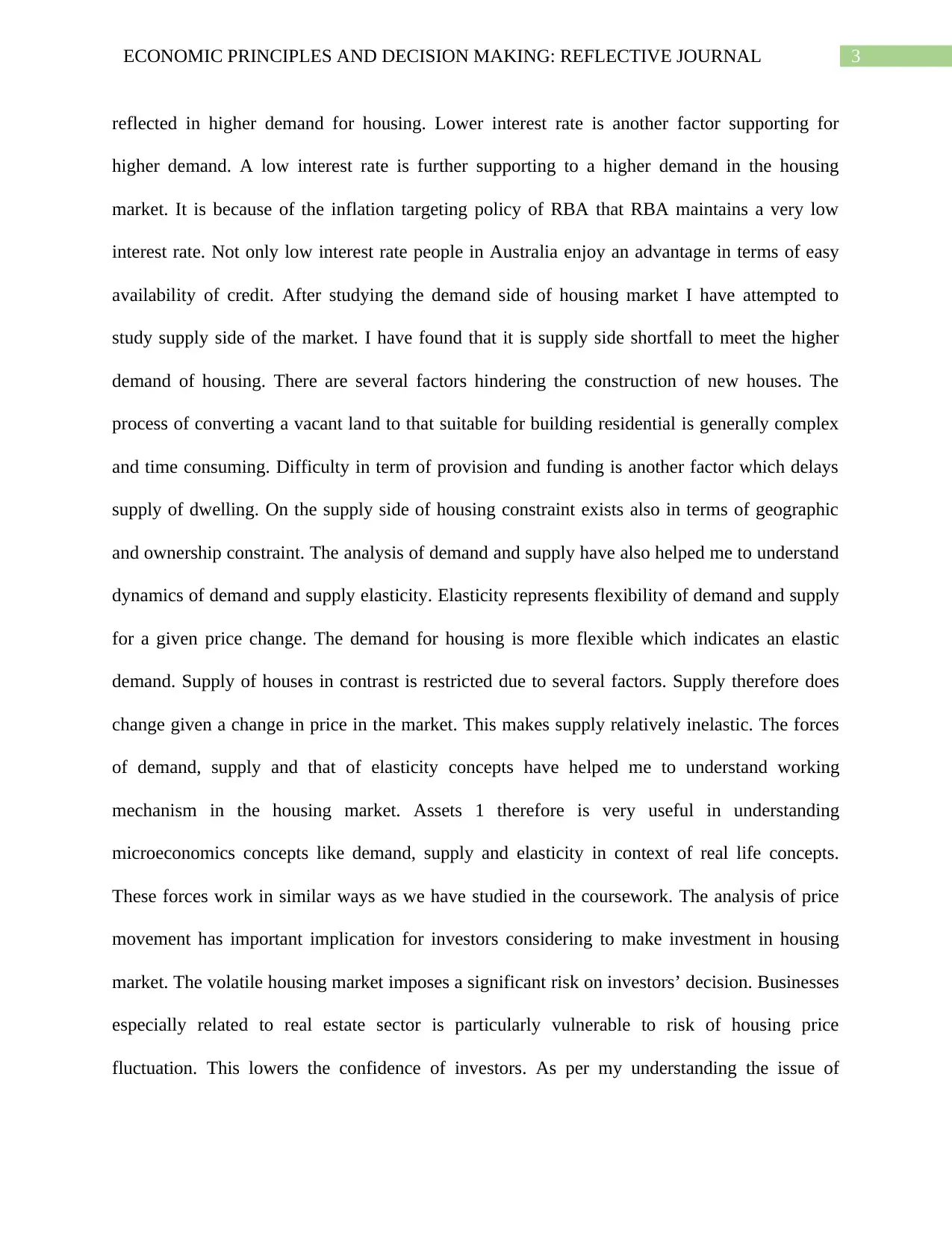
3ECONOMIC PRINCIPLES AND DECISION MAKING: REFLECTIVE JOURNAL
reflected in higher demand for housing. Lower interest rate is another factor supporting for
higher demand. A low interest rate is further supporting to a higher demand in the housing
market. It is because of the inflation targeting policy of RBA that RBA maintains a very low
interest rate. Not only low interest rate people in Australia enjoy an advantage in terms of easy
availability of credit. After studying the demand side of housing market I have attempted to
study supply side of the market. I have found that it is supply side shortfall to meet the higher
demand of housing. There are several factors hindering the construction of new houses. The
process of converting a vacant land to that suitable for building residential is generally complex
and time consuming. Difficulty in term of provision and funding is another factor which delays
supply of dwelling. On the supply side of housing constraint exists also in terms of geographic
and ownership constraint. The analysis of demand and supply have also helped me to understand
dynamics of demand and supply elasticity. Elasticity represents flexibility of demand and supply
for a given price change. The demand for housing is more flexible which indicates an elastic
demand. Supply of houses in contrast is restricted due to several factors. Supply therefore does
change given a change in price in the market. This makes supply relatively inelastic. The forces
of demand, supply and that of elasticity concepts have helped me to understand working
mechanism in the housing market. Assets 1 therefore is very useful in understanding
microeconomics concepts like demand, supply and elasticity in context of real life concepts.
These forces work in similar ways as we have studied in the coursework. The analysis of price
movement has important implication for investors considering to make investment in housing
market. The volatile housing market imposes a significant risk on investors’ decision. Businesses
especially related to real estate sector is particularly vulnerable to risk of housing price
fluctuation. This lowers the confidence of investors. As per my understanding the issue of
reflected in higher demand for housing. Lower interest rate is another factor supporting for
higher demand. A low interest rate is further supporting to a higher demand in the housing
market. It is because of the inflation targeting policy of RBA that RBA maintains a very low
interest rate. Not only low interest rate people in Australia enjoy an advantage in terms of easy
availability of credit. After studying the demand side of housing market I have attempted to
study supply side of the market. I have found that it is supply side shortfall to meet the higher
demand of housing. There are several factors hindering the construction of new houses. The
process of converting a vacant land to that suitable for building residential is generally complex
and time consuming. Difficulty in term of provision and funding is another factor which delays
supply of dwelling. On the supply side of housing constraint exists also in terms of geographic
and ownership constraint. The analysis of demand and supply have also helped me to understand
dynamics of demand and supply elasticity. Elasticity represents flexibility of demand and supply
for a given price change. The demand for housing is more flexible which indicates an elastic
demand. Supply of houses in contrast is restricted due to several factors. Supply therefore does
change given a change in price in the market. This makes supply relatively inelastic. The forces
of demand, supply and that of elasticity concepts have helped me to understand working
mechanism in the housing market. Assets 1 therefore is very useful in understanding
microeconomics concepts like demand, supply and elasticity in context of real life concepts.
These forces work in similar ways as we have studied in the coursework. The analysis of price
movement has important implication for investors considering to make investment in housing
market. The volatile housing market imposes a significant risk on investors’ decision. Businesses
especially related to real estate sector is particularly vulnerable to risk of housing price
fluctuation. This lowers the confidence of investors. As per my understanding the issue of
Paraphrase This Document
Need a fresh take? Get an instant paraphrase of this document with our AI Paraphraser
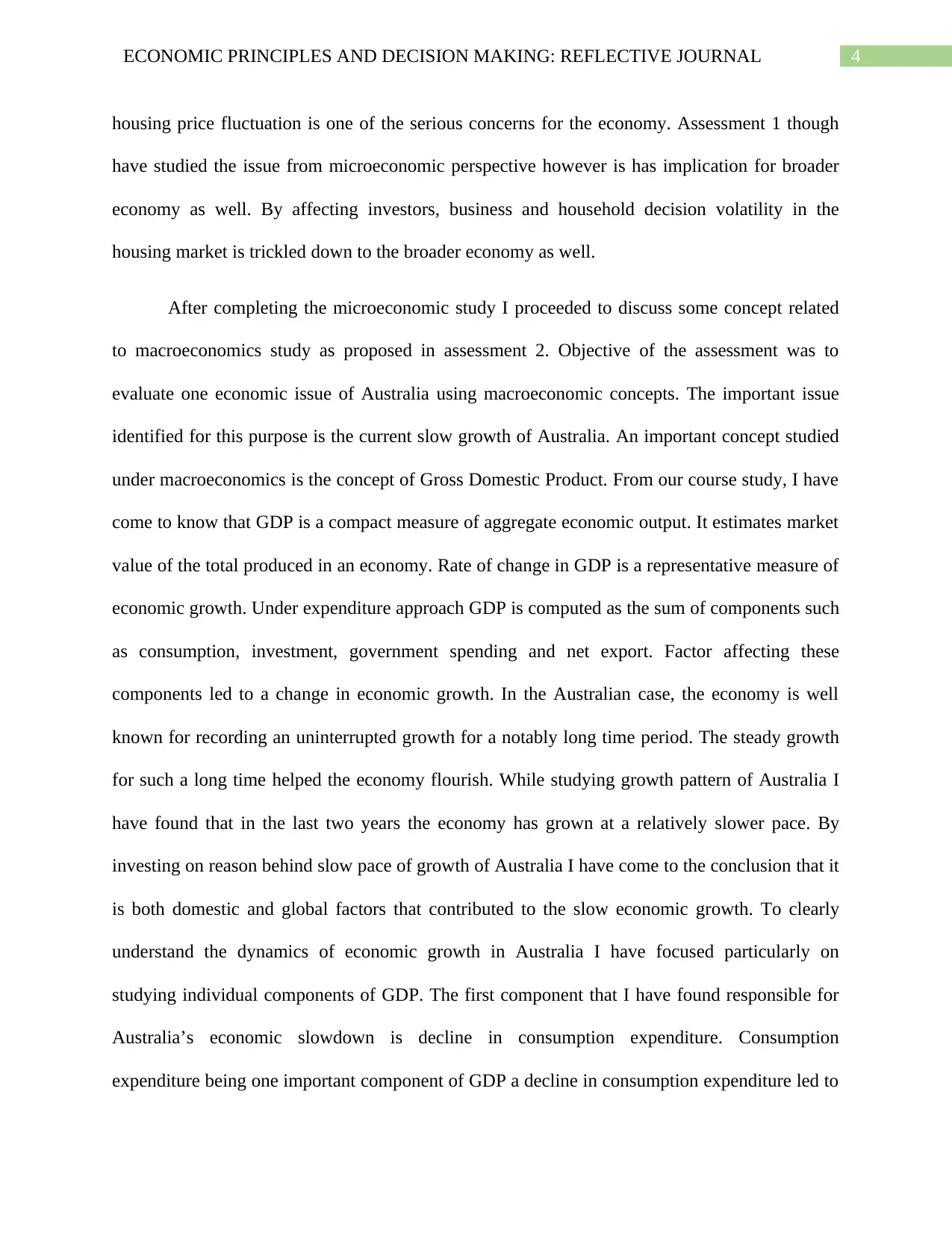
4ECONOMIC PRINCIPLES AND DECISION MAKING: REFLECTIVE JOURNAL
housing price fluctuation is one of the serious concerns for the economy. Assessment 1 though
have studied the issue from microeconomic perspective however is has implication for broader
economy as well. By affecting investors, business and household decision volatility in the
housing market is trickled down to the broader economy as well.
After completing the microeconomic study I proceeded to discuss some concept related
to macroeconomics study as proposed in assessment 2. Objective of the assessment was to
evaluate one economic issue of Australia using macroeconomic concepts. The important issue
identified for this purpose is the current slow growth of Australia. An important concept studied
under macroeconomics is the concept of Gross Domestic Product. From our course study, I have
come to know that GDP is a compact measure of aggregate economic output. It estimates market
value of the total produced in an economy. Rate of change in GDP is a representative measure of
economic growth. Under expenditure approach GDP is computed as the sum of components such
as consumption, investment, government spending and net export. Factor affecting these
components led to a change in economic growth. In the Australian case, the economy is well
known for recording an uninterrupted growth for a notably long time period. The steady growth
for such a long time helped the economy flourish. While studying growth pattern of Australia I
have found that in the last two years the economy has grown at a relatively slower pace. By
investing on reason behind slow pace of growth of Australia I have come to the conclusion that it
is both domestic and global factors that contributed to the slow economic growth. To clearly
understand the dynamics of economic growth in Australia I have focused particularly on
studying individual components of GDP. The first component that I have found responsible for
Australia’s economic slowdown is decline in consumption expenditure. Consumption
expenditure being one important component of GDP a decline in consumption expenditure led to
housing price fluctuation is one of the serious concerns for the economy. Assessment 1 though
have studied the issue from microeconomic perspective however is has implication for broader
economy as well. By affecting investors, business and household decision volatility in the
housing market is trickled down to the broader economy as well.
After completing the microeconomic study I proceeded to discuss some concept related
to macroeconomics study as proposed in assessment 2. Objective of the assessment was to
evaluate one economic issue of Australia using macroeconomic concepts. The important issue
identified for this purpose is the current slow growth of Australia. An important concept studied
under macroeconomics is the concept of Gross Domestic Product. From our course study, I have
come to know that GDP is a compact measure of aggregate economic output. It estimates market
value of the total produced in an economy. Rate of change in GDP is a representative measure of
economic growth. Under expenditure approach GDP is computed as the sum of components such
as consumption, investment, government spending and net export. Factor affecting these
components led to a change in economic growth. In the Australian case, the economy is well
known for recording an uninterrupted growth for a notably long time period. The steady growth
for such a long time helped the economy flourish. While studying growth pattern of Australia I
have found that in the last two years the economy has grown at a relatively slower pace. By
investing on reason behind slow pace of growth of Australia I have come to the conclusion that it
is both domestic and global factors that contributed to the slow economic growth. To clearly
understand the dynamics of economic growth in Australia I have focused particularly on
studying individual components of GDP. The first component that I have found responsible for
Australia’s economic slowdown is decline in consumption expenditure. Consumption
expenditure being one important component of GDP a decline in consumption expenditure led to
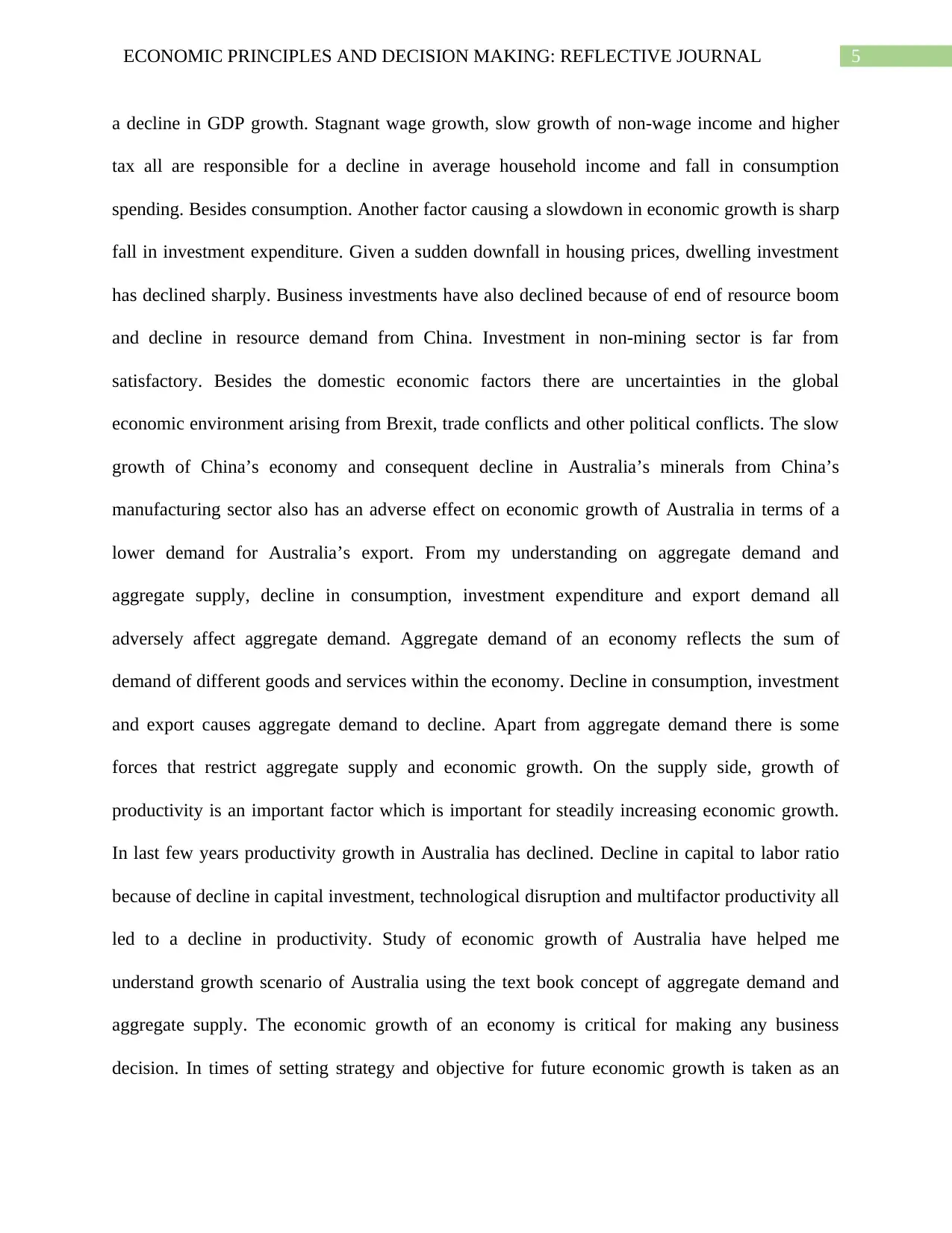
5ECONOMIC PRINCIPLES AND DECISION MAKING: REFLECTIVE JOURNAL
a decline in GDP growth. Stagnant wage growth, slow growth of non-wage income and higher
tax all are responsible for a decline in average household income and fall in consumption
spending. Besides consumption. Another factor causing a slowdown in economic growth is sharp
fall in investment expenditure. Given a sudden downfall in housing prices, dwelling investment
has declined sharply. Business investments have also declined because of end of resource boom
and decline in resource demand from China. Investment in non-mining sector is far from
satisfactory. Besides the domestic economic factors there are uncertainties in the global
economic environment arising from Brexit, trade conflicts and other political conflicts. The slow
growth of China’s economy and consequent decline in Australia’s minerals from China’s
manufacturing sector also has an adverse effect on economic growth of Australia in terms of a
lower demand for Australia’s export. From my understanding on aggregate demand and
aggregate supply, decline in consumption, investment expenditure and export demand all
adversely affect aggregate demand. Aggregate demand of an economy reflects the sum of
demand of different goods and services within the economy. Decline in consumption, investment
and export causes aggregate demand to decline. Apart from aggregate demand there is some
forces that restrict aggregate supply and economic growth. On the supply side, growth of
productivity is an important factor which is important for steadily increasing economic growth.
In last few years productivity growth in Australia has declined. Decline in capital to labor ratio
because of decline in capital investment, technological disruption and multifactor productivity all
led to a decline in productivity. Study of economic growth of Australia have helped me
understand growth scenario of Australia using the text book concept of aggregate demand and
aggregate supply. The economic growth of an economy is critical for making any business
decision. In times of setting strategy and objective for future economic growth is taken as an
a decline in GDP growth. Stagnant wage growth, slow growth of non-wage income and higher
tax all are responsible for a decline in average household income and fall in consumption
spending. Besides consumption. Another factor causing a slowdown in economic growth is sharp
fall in investment expenditure. Given a sudden downfall in housing prices, dwelling investment
has declined sharply. Business investments have also declined because of end of resource boom
and decline in resource demand from China. Investment in non-mining sector is far from
satisfactory. Besides the domestic economic factors there are uncertainties in the global
economic environment arising from Brexit, trade conflicts and other political conflicts. The slow
growth of China’s economy and consequent decline in Australia’s minerals from China’s
manufacturing sector also has an adverse effect on economic growth of Australia in terms of a
lower demand for Australia’s export. From my understanding on aggregate demand and
aggregate supply, decline in consumption, investment expenditure and export demand all
adversely affect aggregate demand. Aggregate demand of an economy reflects the sum of
demand of different goods and services within the economy. Decline in consumption, investment
and export causes aggregate demand to decline. Apart from aggregate demand there is some
forces that restrict aggregate supply and economic growth. On the supply side, growth of
productivity is an important factor which is important for steadily increasing economic growth.
In last few years productivity growth in Australia has declined. Decline in capital to labor ratio
because of decline in capital investment, technological disruption and multifactor productivity all
led to a decline in productivity. Study of economic growth of Australia have helped me
understand growth scenario of Australia using the text book concept of aggregate demand and
aggregate supply. The economic growth of an economy is critical for making any business
decision. In times of setting strategy and objective for future economic growth is taken as an
⊘ This is a preview!⊘
Do you want full access?
Subscribe today to unlock all pages.

Trusted by 1+ million students worldwide
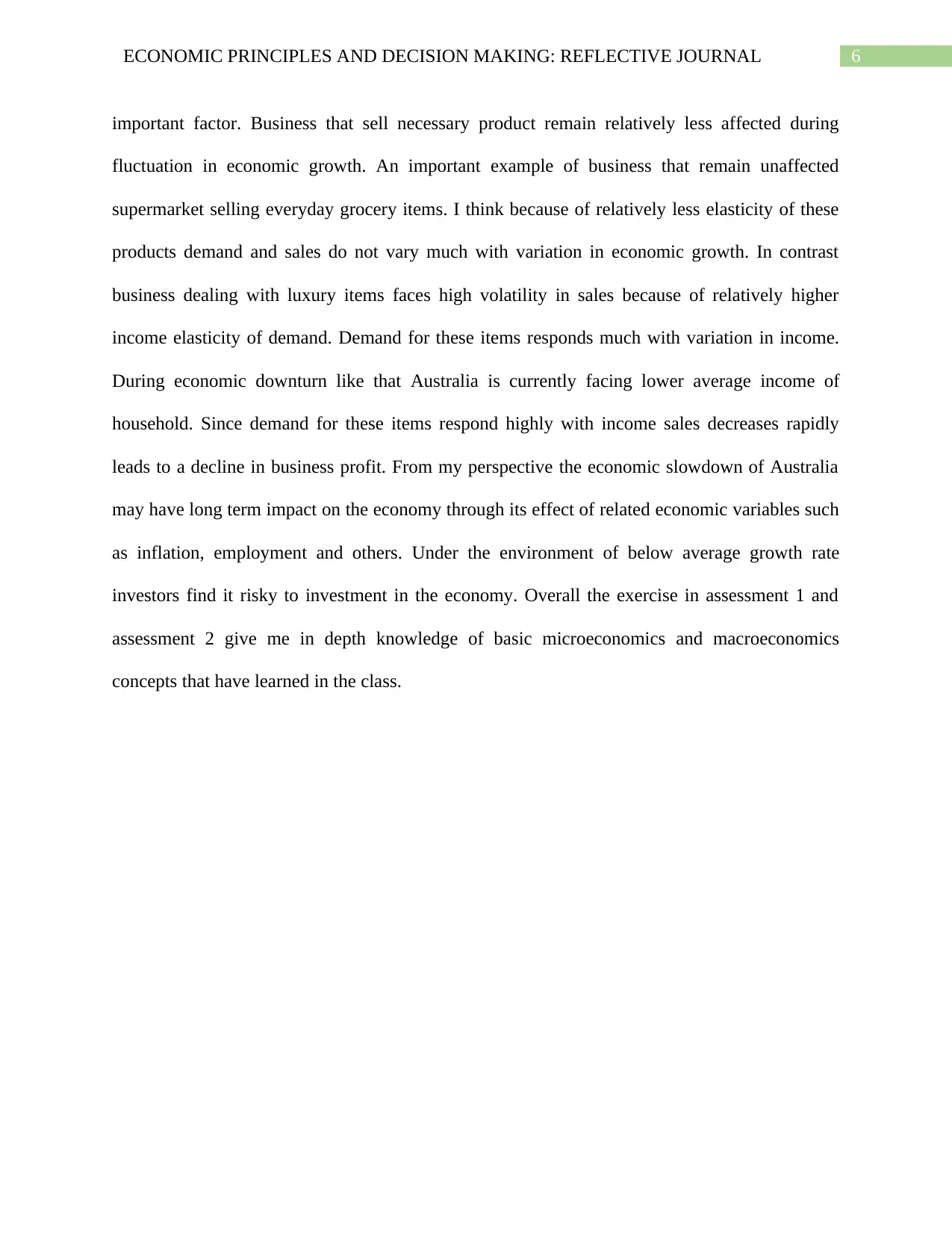
6ECONOMIC PRINCIPLES AND DECISION MAKING: REFLECTIVE JOURNAL
important factor. Business that sell necessary product remain relatively less affected during
fluctuation in economic growth. An important example of business that remain unaffected
supermarket selling everyday grocery items. I think because of relatively less elasticity of these
products demand and sales do not vary much with variation in economic growth. In contrast
business dealing with luxury items faces high volatility in sales because of relatively higher
income elasticity of demand. Demand for these items responds much with variation in income.
During economic downturn like that Australia is currently facing lower average income of
household. Since demand for these items respond highly with income sales decreases rapidly
leads to a decline in business profit. From my perspective the economic slowdown of Australia
may have long term impact on the economy through its effect of related economic variables such
as inflation, employment and others. Under the environment of below average growth rate
investors find it risky to investment in the economy. Overall the exercise in assessment 1 and
assessment 2 give me in depth knowledge of basic microeconomics and macroeconomics
concepts that have learned in the class.
important factor. Business that sell necessary product remain relatively less affected during
fluctuation in economic growth. An important example of business that remain unaffected
supermarket selling everyday grocery items. I think because of relatively less elasticity of these
products demand and sales do not vary much with variation in economic growth. In contrast
business dealing with luxury items faces high volatility in sales because of relatively higher
income elasticity of demand. Demand for these items responds much with variation in income.
During economic downturn like that Australia is currently facing lower average income of
household. Since demand for these items respond highly with income sales decreases rapidly
leads to a decline in business profit. From my perspective the economic slowdown of Australia
may have long term impact on the economy through its effect of related economic variables such
as inflation, employment and others. Under the environment of below average growth rate
investors find it risky to investment in the economy. Overall the exercise in assessment 1 and
assessment 2 give me in depth knowledge of basic microeconomics and macroeconomics
concepts that have learned in the class.
Paraphrase This Document
Need a fresh take? Get an instant paraphrase of this document with our AI Paraphraser

7ECONOMIC PRINCIPLES AND DECISION MAKING: REFLECTIVE JOURNAL
1 out of 8
Related Documents
Your All-in-One AI-Powered Toolkit for Academic Success.
+13062052269
info@desklib.com
Available 24*7 on WhatsApp / Email
![[object Object]](/_next/static/media/star-bottom.7253800d.svg)
Unlock your academic potential
Copyright © 2020–2025 A2Z Services. All Rights Reserved. Developed and managed by ZUCOL.





